12 Historic Things to Do in Arles, France
12 min readAs we walked into the old town of Arles, I had the biggest grin on my face. The sun was shining, church bells were ringing, and I could see street...
The post 12 Historic Things to Do in Arles, France appeared first on Teaspoon of Adventure.
As we walked into the old town of Arles, I had the biggest grin on my face. The sun was shining, church bells were ringing, and I could see street after street of cute shops and restaurants waiting to be discovered.
I guess you could say Arles had me at bonjour.
Arles is a city in France’s Provence region most well known for inspiring many of Van Gogh’s paintings and for once being a capital of Ancient Rome. Today, that means the city is full of artistic scenes and Roman artifacts.
My husband, Colin, and I spent about 10 days exploring the South of France in February 2024 and Arles was absolutely one of my favourite stops. I found this city so charming and so full of things to see, do and explore.
Below I’m sharing 12 historic and awesome things to do in Arles, plus my tips for how to get there and where to stay. Let’s explore Arles!
Disclosure: Some of the links below are affiliate links, meaning if you click through and make a purchase, I will earn a small commission at no additional cost to you. Thanks for your support!
1. Visit the Cloître Saint-Trophime

The Cloître Saint-Trophime or Cloister of St. Trophime is one of the best preserved Roman sites in Arles, dating back to the 12-14th Centuries.
Because it took over two centuries to finish the cloister, it represents both Romanesque and Gothic architecture. I don’t know much about art history, but I found this place very pretty!
It’s a small site, but I always love walking around a cloister. The arches and central courtyard always do it for me!
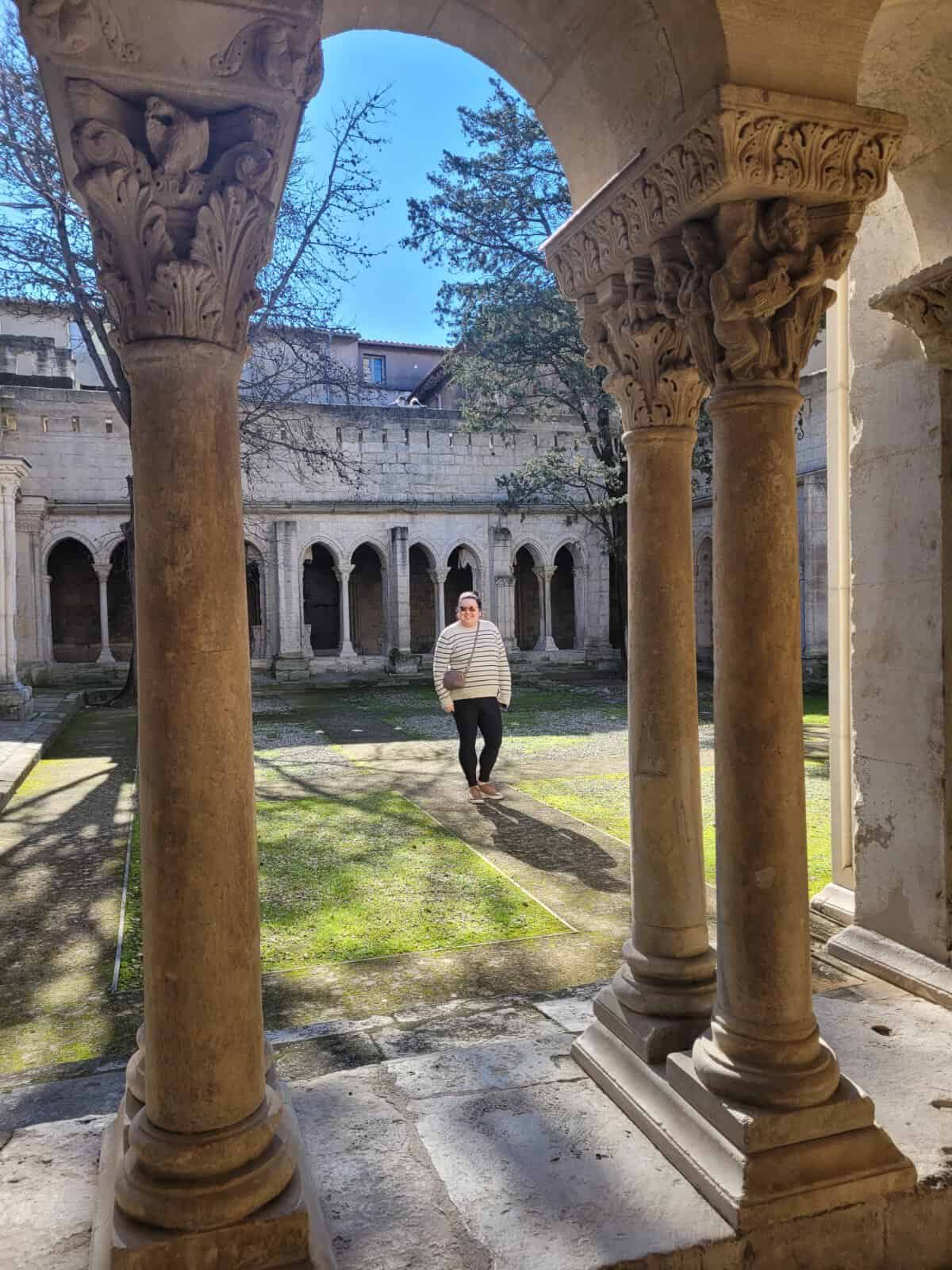
The Cloître Saint-Trophime was particularly worth walking around as it was so detailed. I was really blown away by the intricate carving and stonework.
Besides the bottom floor of the cloister, you can also walk around the upper building to see some more artwork, as well as up to the rooftop.
Because we visited in February, we pretty much had the entire cloister to ourselves. There was only one other couple sitting on a bench up on the rooftop, but they kind of fit in with the historic and romantic vibe of the place.
2. Walk around the Arles Amphitheatre
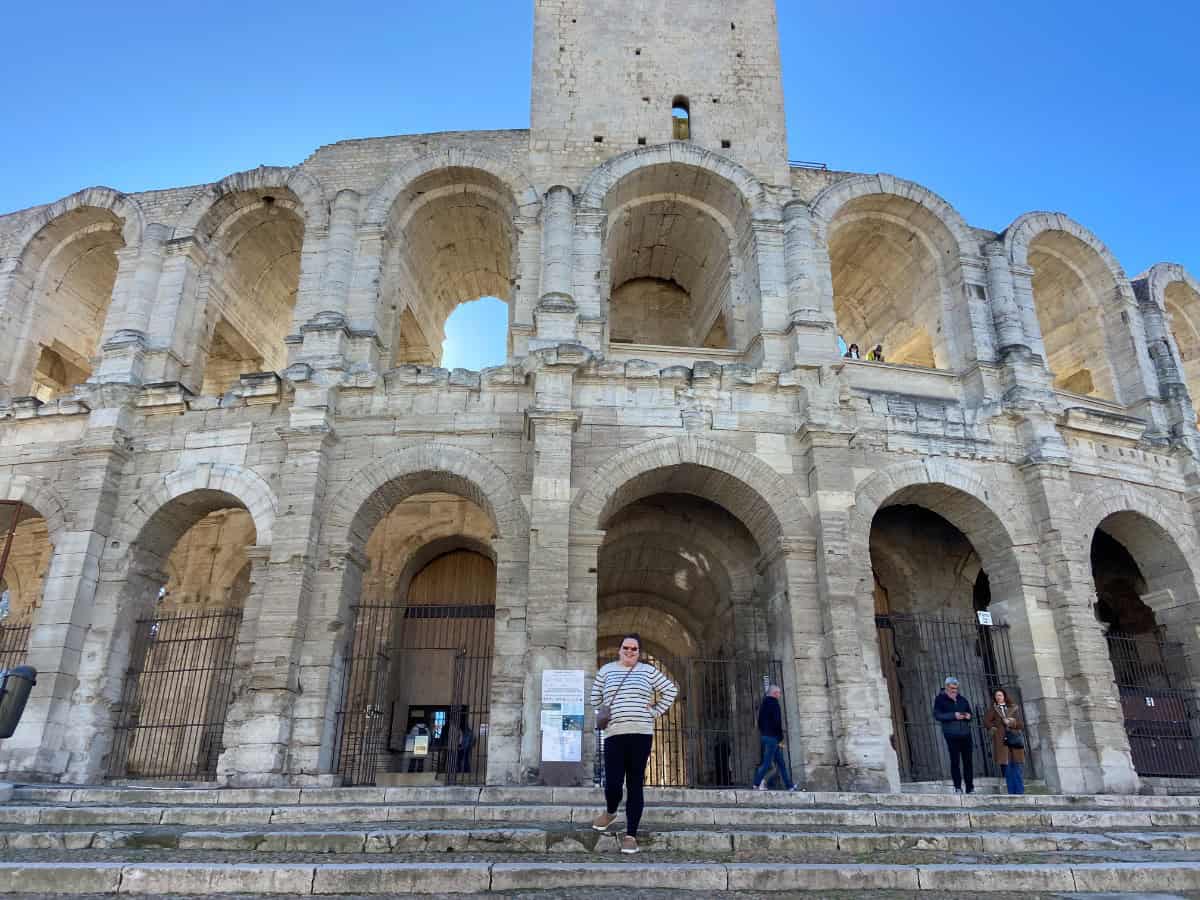
The Arles Amphitheatre or Arènes d’Arles is the highlight of the Roman monuments in town and, in my opinion, a must-visit.
The amphitheatre was built in 90 AD and held 20,000 people who watched chariot races and gladiator battles. Today it’s used for bullfights, plays, concerts and tours for visitors like us.
We ended up arriving on the far side of the arena, which meant we had to circle the whole thing to get to the entrance. But this was actually really cool as we got to fully understand how huge and imposing this place is.
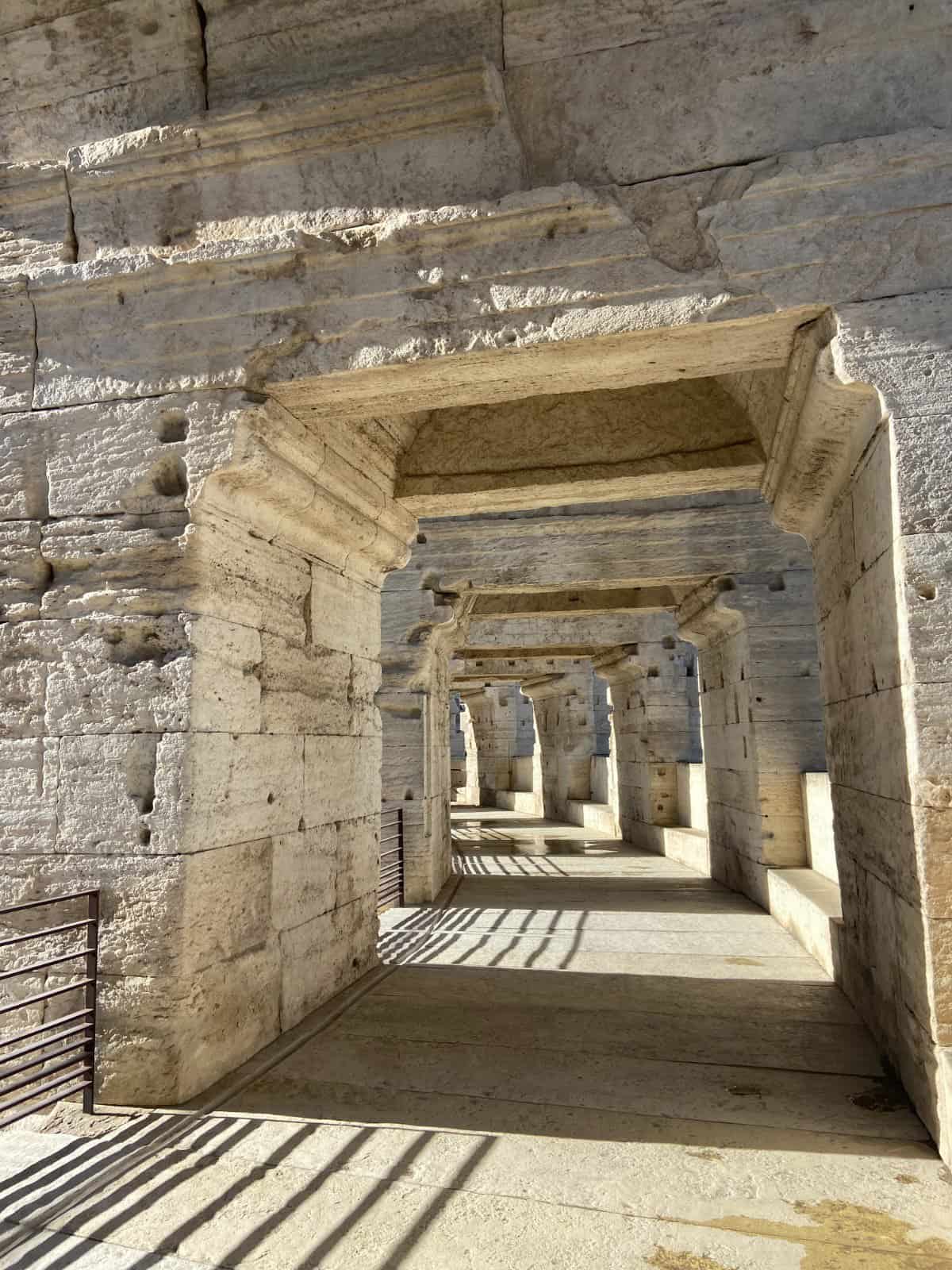
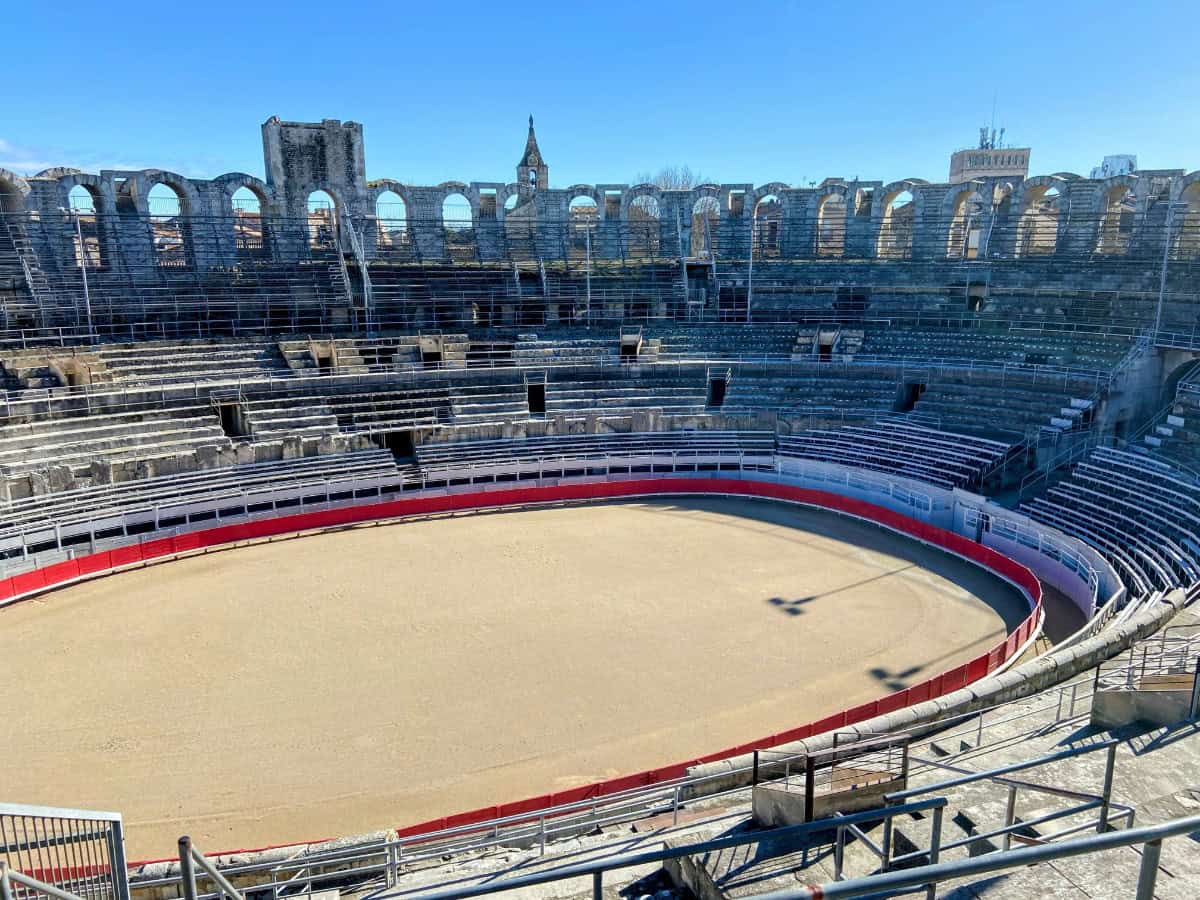
Inside, I loved walking around the different tiers and exploring the arena. There weren’t many plaques to read and we didn’t see an audioguide, so it was mostly just checking the place out.
It’s wild to think that a mini Colosseum like this was all ours to explore (the bonus of off-season travel) and still used for shows to this day.
3. Tour the Roman Theatre of Arles
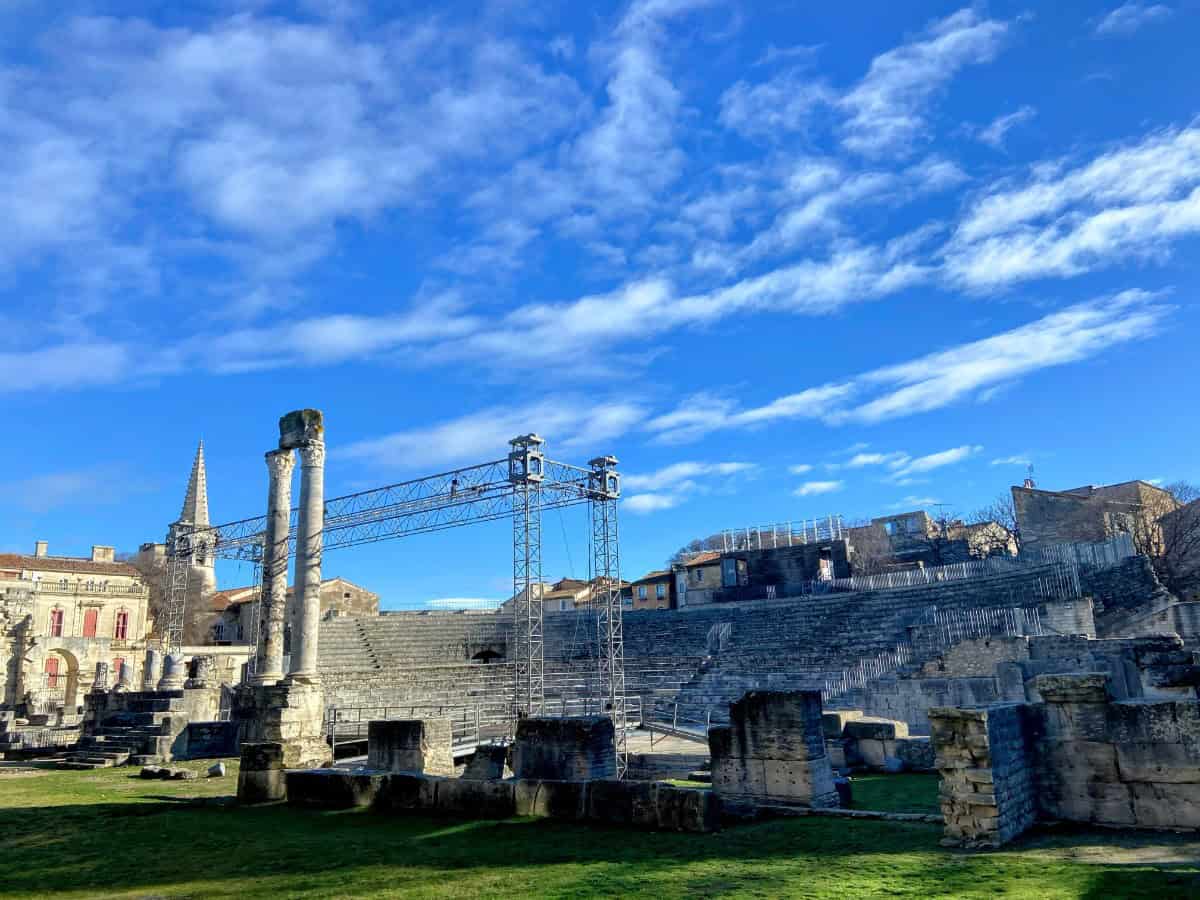
The Roman Theatre of Arles (Théâtre Antique d’Arles) isn’t looking as good as it did back in the 1st Century. Today it is mostly ruins, but still worth a stop.
Back in the time of Caesar Augustus, the theatre held 8,000 spectators, similar to the theatre in Orange (though that one is in much better shape!).
We actually didn’t pay to enter the theatre, but instead checked it out from the other side of the gate. While I’m sure walking around the site and reading any information available would be great, we got a good feel for the place just from the outside.
So if you’re short on time or want to skip a few of the Roman monuments, I think you’d be okay to just see this one on a pass by.
4. Grab a snack at the Arles Market
It’s time to grab a quick snack and refuel before exploring more of Arles. If you happen to be in Arles on a Wednesday or Saturday morning, you’re in luck because that’s market day!
The Arles Market is an outdoor, mostly-food market that’s open for a few morning hours twice a week.
Here you’ll find lots of local produce, like cheese, meats, fruits and vegetables. But there are also ready-to-eat stalls with snacks perfect for a little mid-morning pick me up.
Besides food, the market also sells clothing, antiques, flowers and artisan products – perfect for souvenir shopping!
Unfortunately, we did not visit Arles on a Wednesday or Saturday, so didn’t get to experience the Arles Market in person. Just another reason to go back!
5. Stop by the Thermes de Constantin
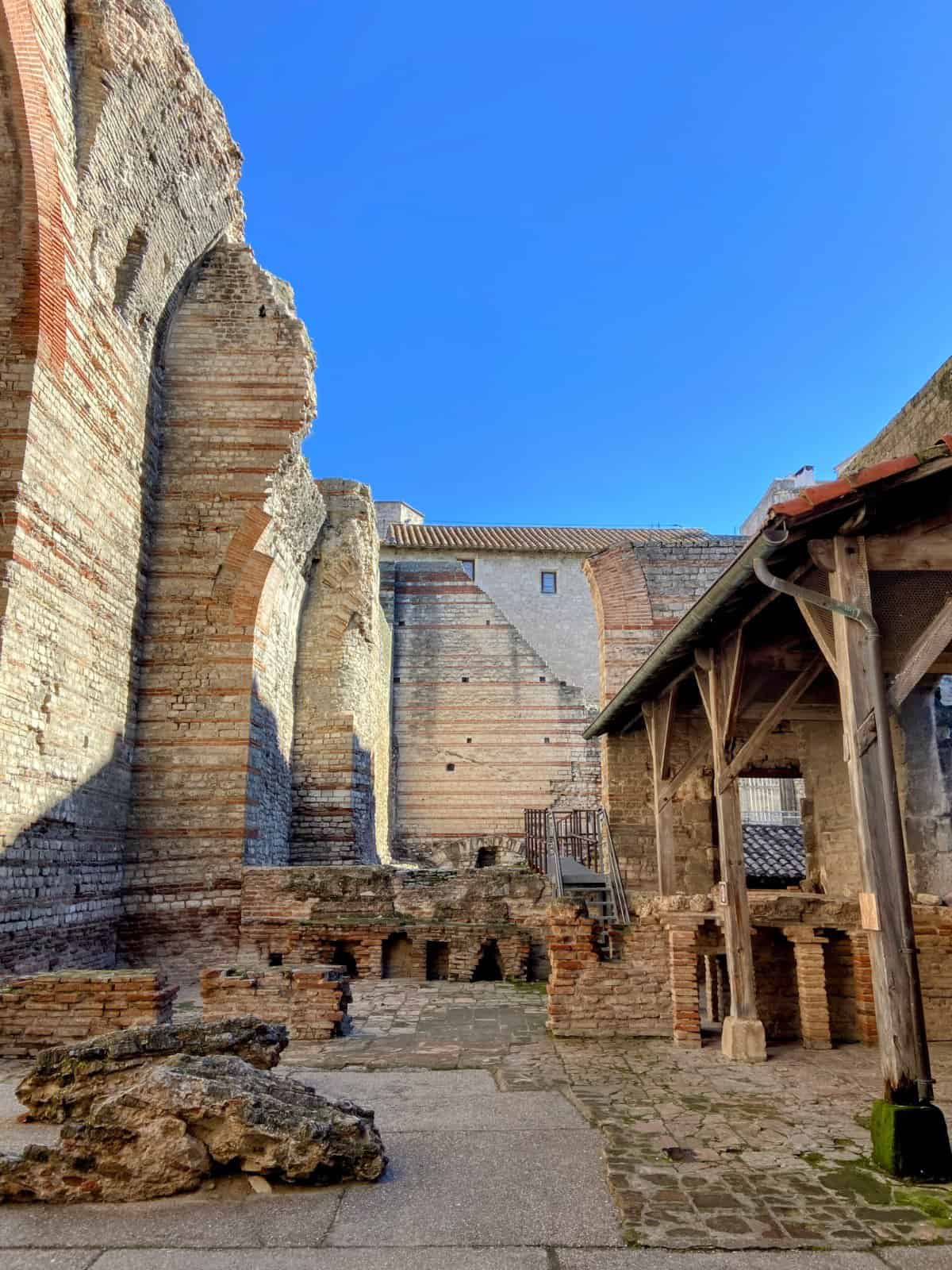
The Thermes de Constantin or Baths of Constantine are Roman baths that date back to 400 AD.
Today, the site is mostly ruins, but you can still see where the baths were housed and imagine rubbing shoulders with Ancient Romans on a visit to the public bathhouse.
The site is quite small but Colin and I had it all to ourselves.

Like most of the Roman monuments in Arles, there wasn’t a ton of information to read but we enjoyed walking around and checking out the baths.
We saw where the caldarium, or hot pools, would have been and how they were heated underneath. And we saw the nearby frigidarium, or cold pools. It reminded me of my tour of the Roman Baths in Bath (though those ones are much more extensive).
6. Visit the Alyscamps
The Alyscamps is a Roman cemetery a little ways outside of the centre of Arles. It was once one of the most famous necropolises and used by Arles’ deceased for over 1500 years.
The Alyscamps was so popular that people used to ship coffins from all around Europe to Arles to be buried there. The cemetery got so crowded that they had to stack coffins three deep!
Unfortunately, the Alyscamps fell into ruin starting in the Renaissance. It was looted, sarcophagi were given away as gifts, rocks were used as building materials, and eventually a railway and canal were built through it.
Today, you can still go and visit the ruins of this ancient necropolis. However, most of the sarcophagi are in a nearby museum.
7. Admire the Arles Cafe Van Gogh
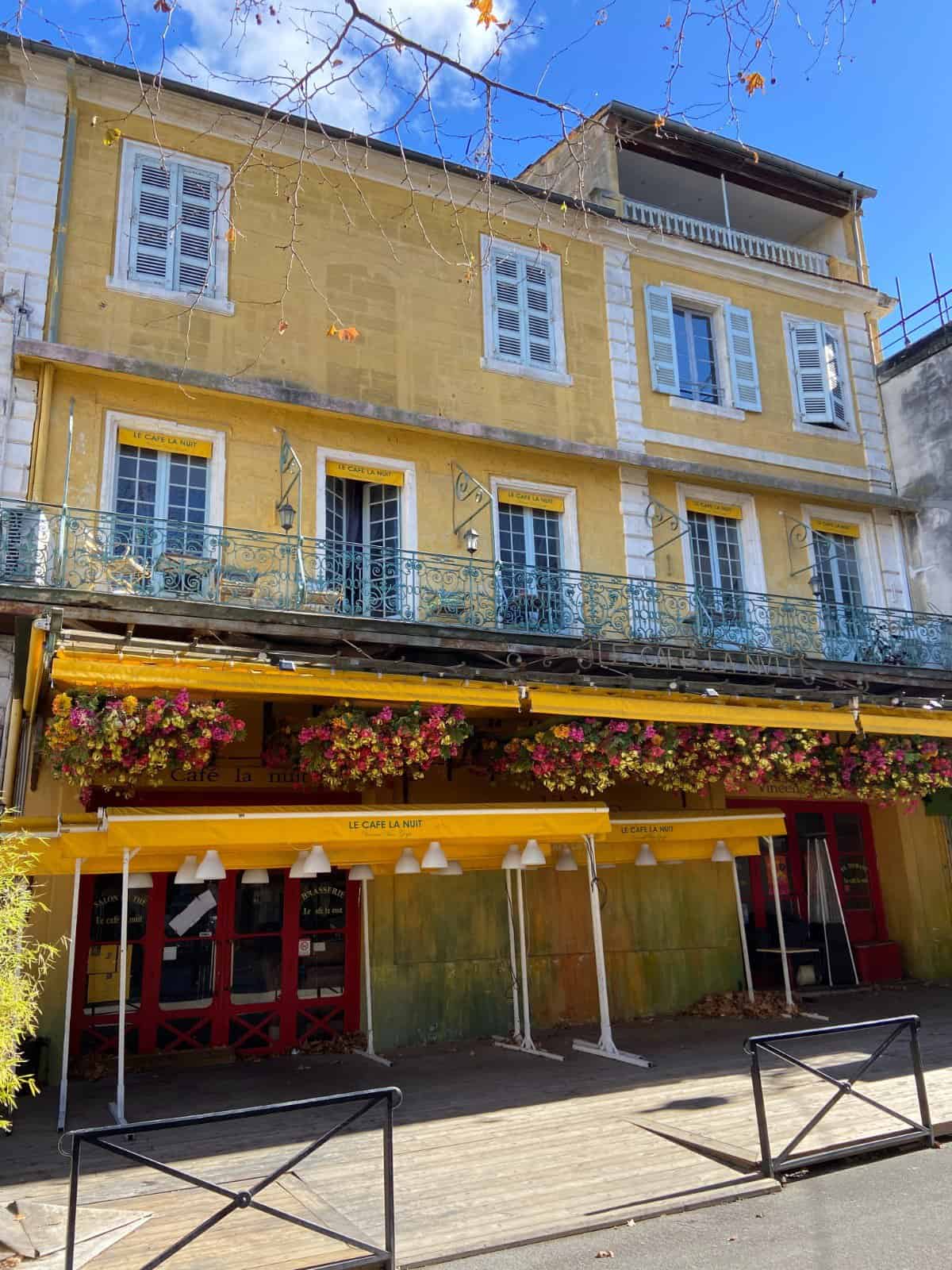
One of the most popular sites in Arles is Cafe Van Gogh (aka Le Cafe la Nuit), so nicknamed because this cafe inspired Van Gogh’s famous 1888 painting, Café Terrace at Night.
However, there is some controversy with this place…
While Van Gogh did paint Café Terrace at Night while in Arles, the current “Arles Cafe Van Gogh” is actually a recreation from the 2000s. The original cafe was located elsewhere in Arles and, sadly, was destroyed by bombs in 1944.
But there’s even more controversy: The recreated cafe is closed due to, what sounds like, tax fraud! The owners were accused of concealing millions of dollars in sales and there have now been fines, bankruptcies and prison sentences (!) involved.
Luckily for us visitors, the Cafe Van Gogh is still available for a photo opp, though remains closed with no certain future as of 2024.

If you’re hungry, you can do what we did, and grab lunch at one of the restaurants in the square nearby. We ate at Mon Bar where I had an amazing octopus dish with vegetable quiche. Colin got a burger and really enjoyed it.
8. Go on a self guided Vincent Van Gogh walking tour of Arles
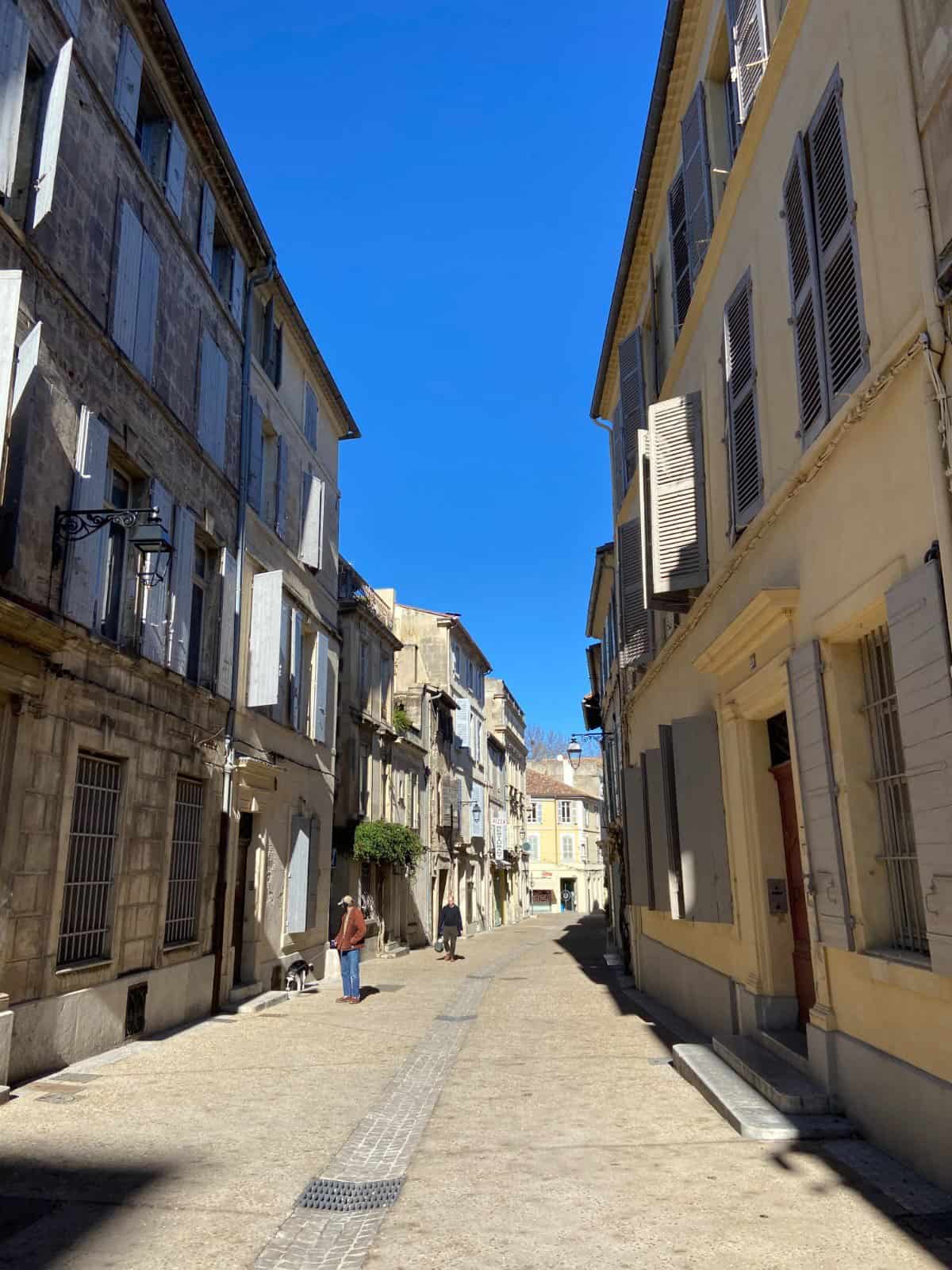
Even though the Van Gogh Cafe in Arles is a bit of a farce, there is still a lot of Van Gogh history to soak up in Arles.
Vincent Van Gogh lived in Arles from February 1888 to May 1889, before admitting himself to a psychiatric institution in St. Remy-de-Provence (which we visited after Arles!).
He was a prolific painter while in Arles but sadly suffered from some mental health episodes while there, including the infamous cutting off of his ear.
Follow along on this map to trace Van Gogh’s footsteps through Arles. You can see where he painted some of his famous works, as well as where he lived, worshipped, hung out and was hospitalized.
Of course, you can also visit the Arles Vincent Van Gogh Foundation to learn even more about the famous painter and his works!
9. Go underground at the Cryptoportiques d’Arles
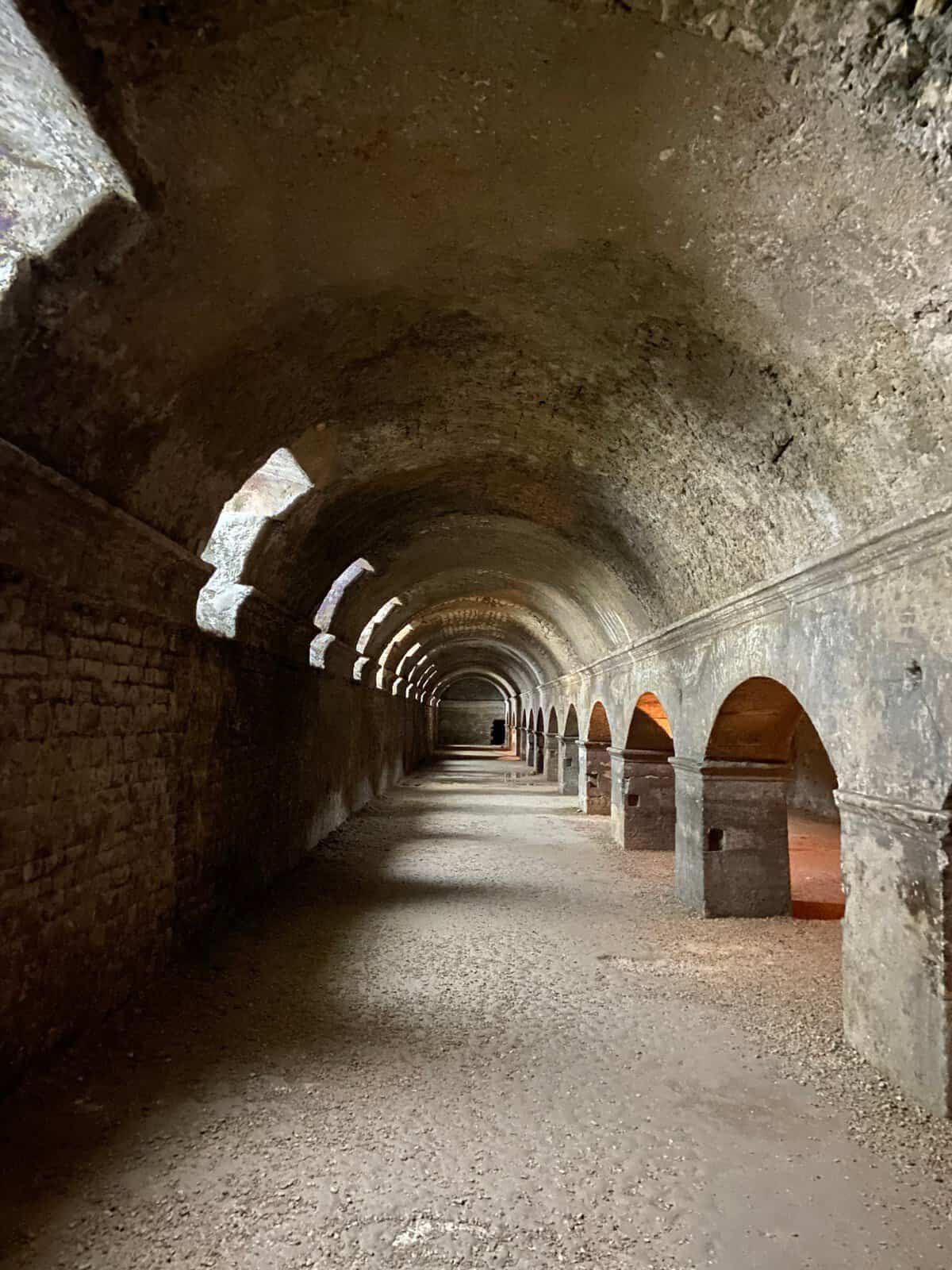
My favourite of all the historic sites we saw in Arles was the Cryptoportiques d’Arles or Arles crypt.
The Arles crypt was built in 100 BC, likely by the Greeks, and served as a foundation for the forum above it (now a chapel and city hall). It’s believed it was used as slave barracks.
When Colin and I visited on a February morning we were, perhaps unsurprisingly, the only people in the crypt. And let me tell you, I was creeped out! It was spooky to walk down long, dark tunnels all by ourselves.
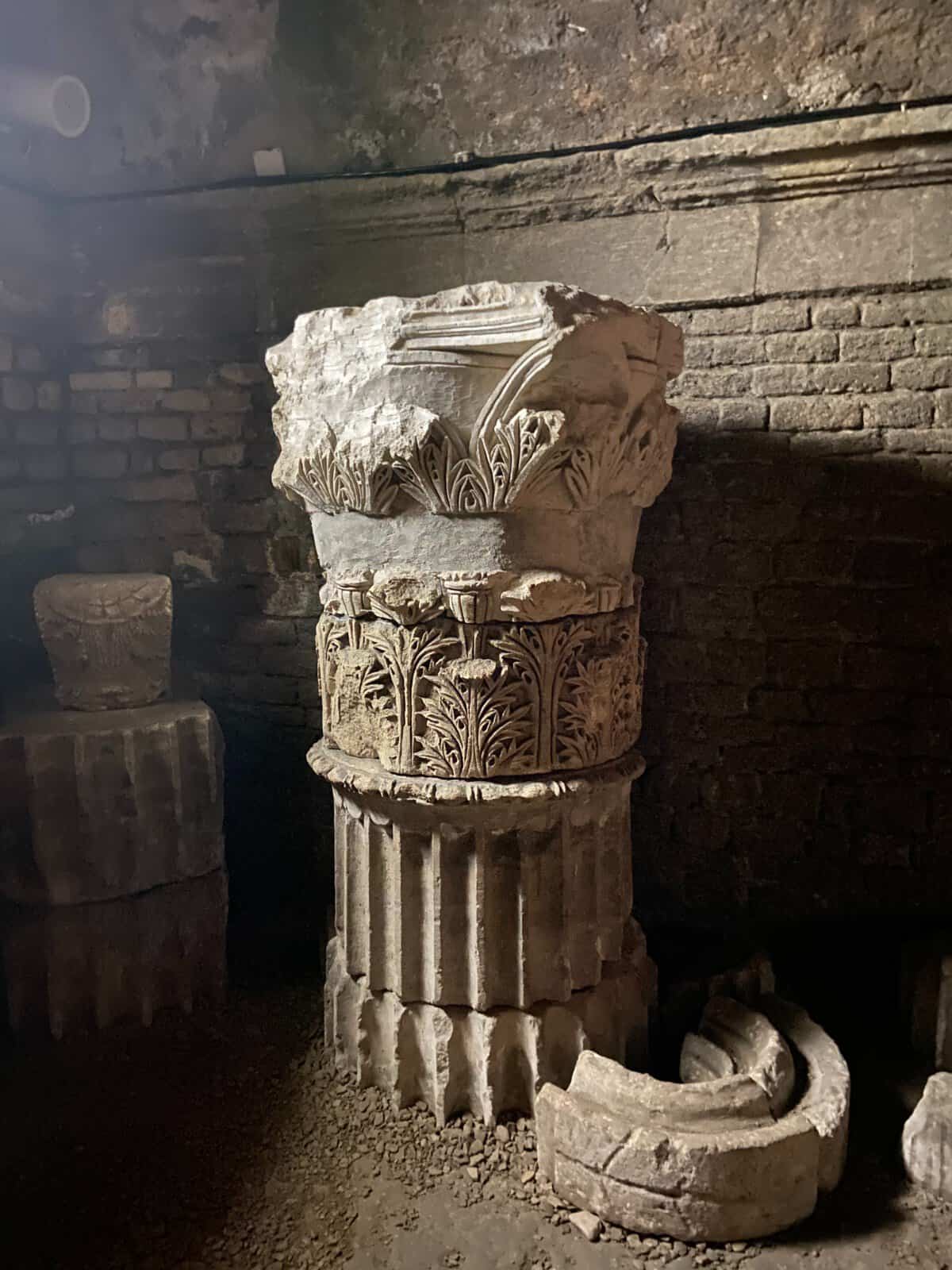
But it was also really cool! The crypt was way bigger than I thought it would be, with a few secret rooms off of the tunnels, as well as some intricately carved rocks and pillars.
There were a few info boards, but unfortunately they were all in French so we didn’t get much from them. Still, walking through the crypt was such an interesting experience!
10. Check out LUMA Arles

While I promised you 12 historic things to do in Arles, this one is actually on the modern side. And that’s because LUMA Arles is a contemporary art museum.
LUMA is located a little outside of Arles’ old town and known for its distinctive exterior – which includes a slide! And the best part? Entrance is free!
Sadly, we didn’t leave ourselves enough time to tour LUMA, but I definitely would like to come back and see it. We’ll have to dedicate a whole day to it, since it’s a 27-acre creative campus!
I like that a city as historic as Arles can still celebrate more modern art. I’ve only heard good things about LUMA so can’t wait to experience it myself on our next visit to Arles.
11. Go for a stroll around town
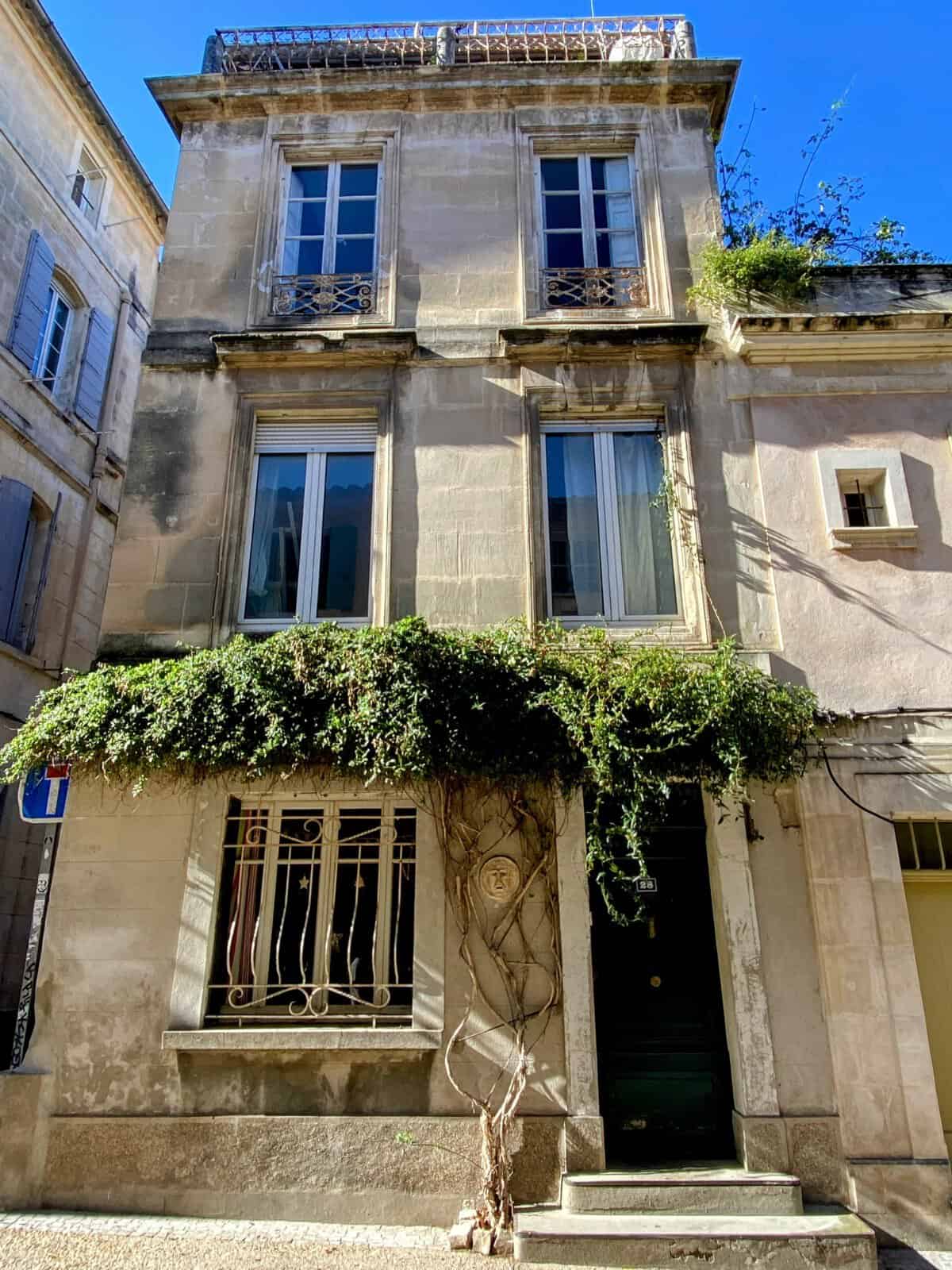
While there’s so much to see and do, Arles is also the kind of city you could just wander around without an agenda.
As we hunted for a lunch place, I loved walking along the Rhône River and down different quiet streets, just exploring the city.
We lucked out with a sunny, winter day, so the streets were beautiful, but quiet. I’m sure they’re a lot more bustling in the summer, but I liked out little winter retreat.
It really felt like we had walked into a fairytale. I highly recommend leaving yourself some free time in Arles to just wander!
12. Visit one of the Arles museums
If you opt for one of the Roman monument passes (more on those below!), you’ll also receive access to some of Arles’ museums: Musee Reattu, Musee departemental de l’Arles antique, and Musee de Camargue.
Musee Reattu is an art museum, mostly dedicated to the works of Arles’ born painter, Jacques Réattu.
Musee de Camargue is a folk museum telling the history of the Camargue, an area south of Arles known for its wildlife. If you want to experience the Camargue properly though, go on this Camargue Safari from Arles!
Musee departemental de l’Arles antique, also known as the Blue Museum thanks to its blue exterior, is an archeological museum. It houses antiques from the area, including many of the sarcophagi from the Alyscamps.
Other museums in Arles include Paul Ricard Museum, Museon Arlaten and Provençal Santon Conservatory.
Save money on the top Arles, France things to do
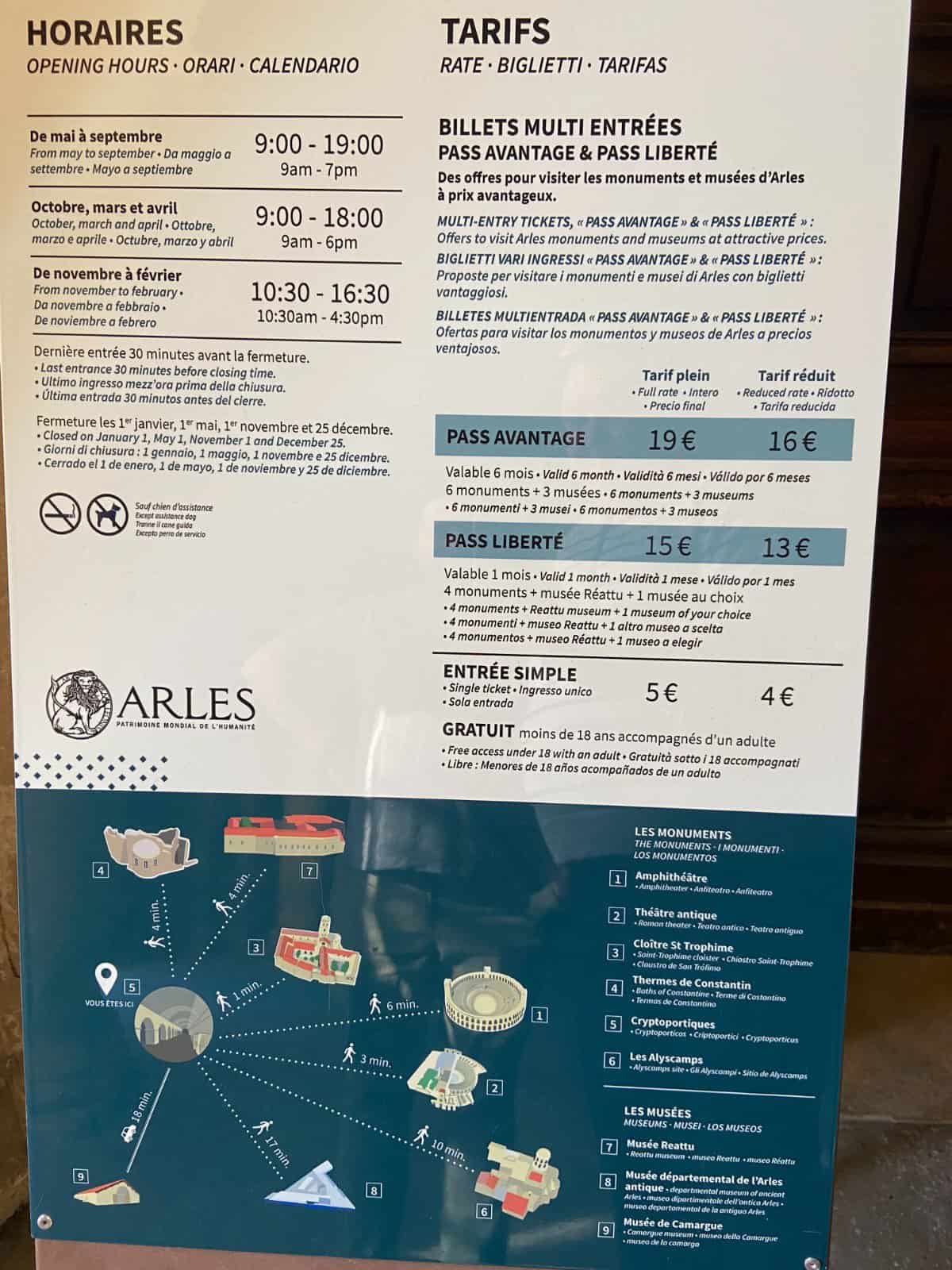
If you plan to visit a few of the monuments and/or museums in Arles, look into these special passes. Prices and restrictions below are valid as of our Feb 2024 visit.
The Pass Avantage (valid for six months) grants you entrance to six monuments and three museums for €19 while the Pass Liberté (valid for one month) grants you entrance to four monuments and two museums for €15.
Otherwise, if you’re visiting each museum or monument on its own, it’s €5 for a single ticket.
Colin and I opted for the Pass Liberté, which allowed us to visit four monuments. Sadly, we ran out of time to fit in the two included museums. But still, we saved money!
If you’re staying in Arles for a few nights or plan to see at least three monuments, definitely buy a pass. It’s a great way to save money and stop by a monument or museum you may have otherwise missed.
You can pick one up at the first monument or museum you visit. No need to buy ahead!
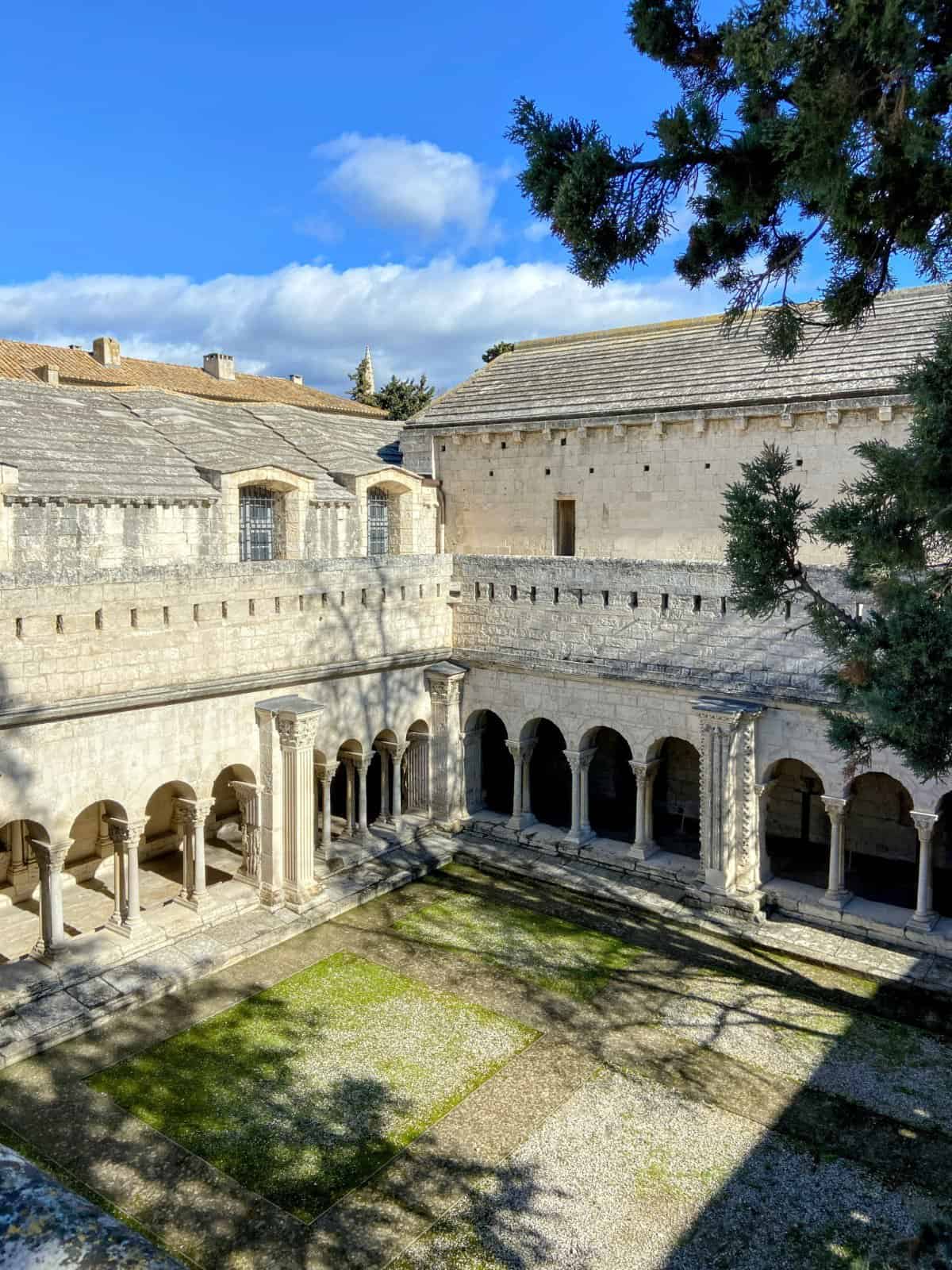
How to get to Arles
Arles is in Provence, in the south of France by Avignon, Montpellier and Marseille. Here’s how to get there from nearby cities:
Avignon to Arles
To get to Arles from Avignon, it’s a 45 minute drive or 15 minute TER train ride. Note that this train leaves from Gare d’Avignon Centre, which is a 15-20 minute walk from Palais des Papes in the centre of the old town.
We stayed in Avignon and drove to Arles. The drive was easy – there were a lot of roundabouts but that’s France for you!
We chose to drive because we were hitting a few more provencal towns on the same trip, but if you’re only going to Arles from Avignon, I’d recommend taking the train. It’s much faster and you don’t have to worry about parking!
Book your Avignon to Arles train tickets here!
Nîmes to Arles
You can travel the distance from Nîmes to Arles in 45 minutes by car or 20 minutes by Intercités train.
Many people pair Nîmes and Arles, as both are known for their Roman relics. Stay tuned for a post where I’ll compare which one to visit if you’re short on time.
Book your Nîmes to Arles train tickets here!
Arles from Montpellier, Aix, Marseille or Paris
If you’re visiting Arles from a little further afield, here’s how you’ll travel:
- From Montpellier to Arles, it’s an 80 minute drive or 50 minute Intercités train.
- From Aix-en-Provence to Arles, it’s a 70 minute drive or two hour TER train journey.
- From Marseille to Arles, it’s about 90 minutes by car or by train and bus/metro.
- From Paris to Arles, it’s 7.5 hours by car or 3.5 hours by train.
Parking in Arles
If you’ve decided to drive to Arles, I highly recommend finding a parking garage before you arrive. It’s much easier to navigate straight to a parking garage, rather than navigating to the town centre and then trying to find one.
When we visited Arles, the Tour de Provence bike race was on, which meant many of the main streets were closed. This made it doubly hard to get around and I was very grateful we had thought to look for parking ahead of time.
We parked at Parking du Centre, Arles which was just outside the old town but within easy walking distance of the main sites.
If you’re renting a car, I recommend booking through Discover Cars or AutoEurope. We’ve rented with both all over the world and have had great experiences!
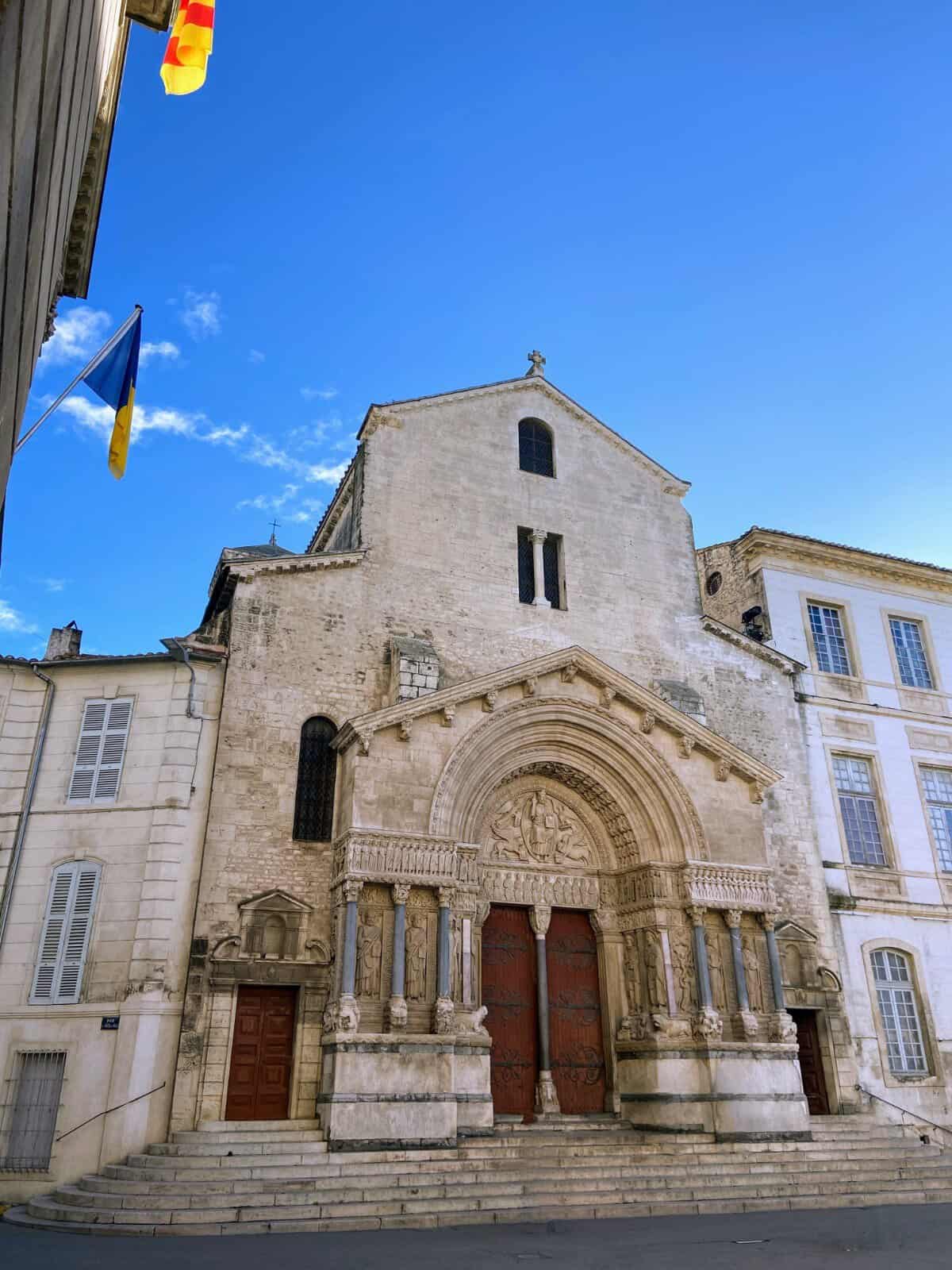
Where to stay in Arles
We didn’t stay overnight in Arles, as we were based in Avignon for this leg of our trip, but if you’d like to stay in Arles, here are some recommended hotels:
- L’Hôtel Particulier: For a luxury stay in a 18th-Century villa with historic touches and a private pool, this place looks stunning!
- La Résidence Arles Centre: For an affordable stay with a little more space, you might like these apartment rentals.
- Maison Douce Arles: For some homey charm and a delicious start to the day, check out this bed and breakfast.
Wrapping up things to do in Arles: Should you visit?
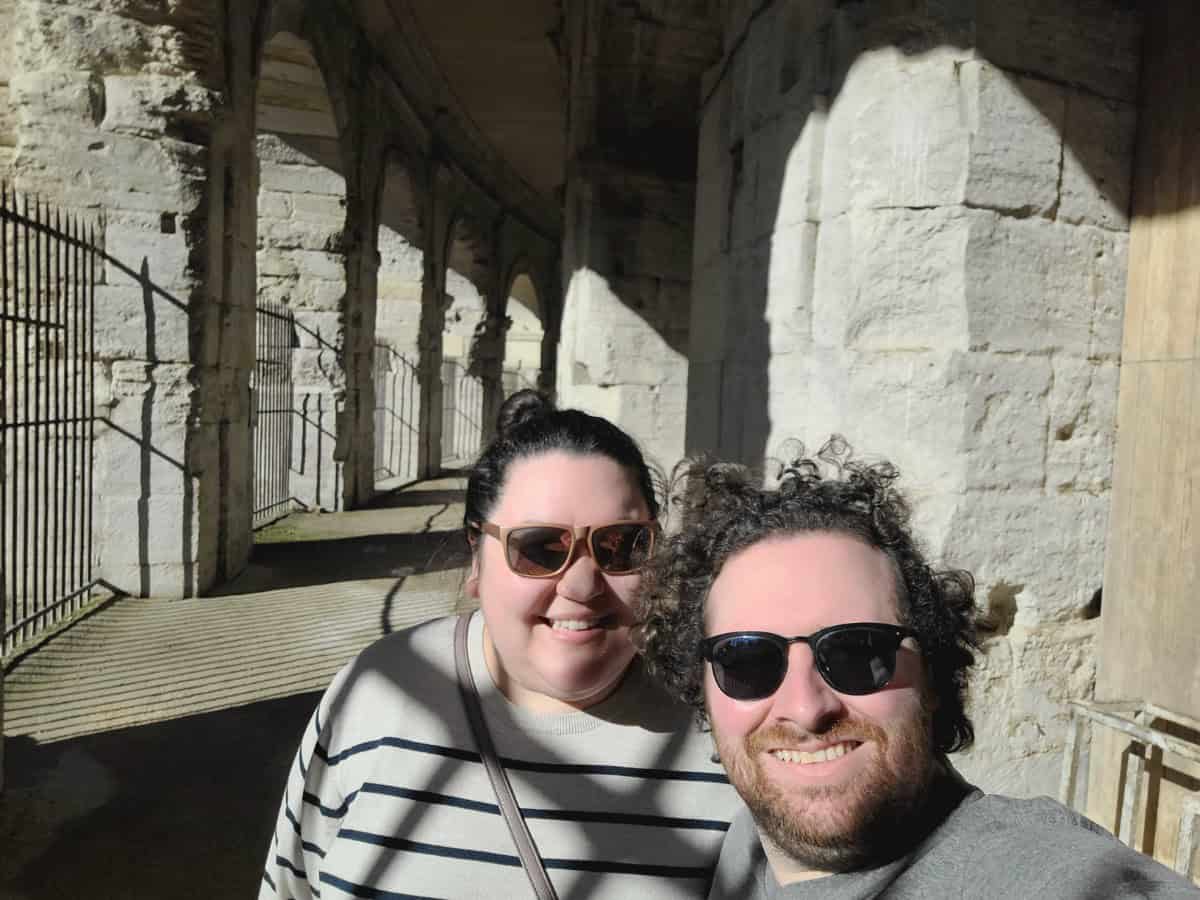
If you’re into art or Ancient Roman history, Arles is a must visit. With so many Roman ruins, museums and Van Gogh sites available, you’ll be spoilt for choice!
But even if you’re not hugely into history or art (I’m not!), I still think Arles is worth visiting.
A lot of the historic sites are accessible to newcomers. You don’t have to have a ton of knowledge about Ancient Rome or Van Gogh to appreciate these places. You can learn a bit or just enjoy walking around a cool spot.
More than that, Arles is a really charming town. I think even if you skipped every Roman monument and had no idea Van Gogh once lived there, you’d still enjoy a day in Arles.
I really loved visiting Arles, especially in the off-season. I could see returning in the spring and spending a few quiet weeks just soaking up the loveliness of this place.
So have I convinced you? Is Arles now on your France bucket list?


